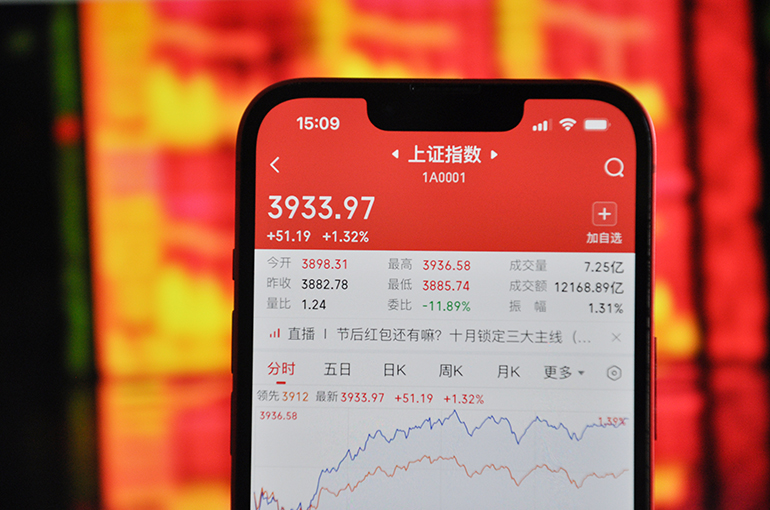(Yicai) Oct. 10 — Shanghai’s benchmark stock index reached a 10-year high for the second time in two months on the day trading resumed after the extended National Day holiday. Analysts believe that the momentum could continue throughout the fourth quarter.
The Shanghai Composite Index [SHA: 000001] closed up 1.3 percent at 3,933.94 yesterday, the highest since August 2015, but fell 0.5 percent to 3,913.8 as of lunch break today. The index, which also hit a 10-year record on Aug. 18, has surged about 17 percent so far this year.
The Shenzhen Component Index [SHE: 399001] added 0.5 percent to 13,725.56 yesterday, while the ChiNext Index [SHE: 399006] jumped 0.7 percent to 3,261.82. They dropped 1.9 percent and 3.4 percent, respectively, today but have climbed around 31 percent and 52 percent so far this year.
“The belief that the market is still in a second bullish stage has not changed, and neither has the incremental inflow trend,” said Zhang Xia, chief strategy analyst at China Merchants Securities. “These are the key forces driving the market to rise steadily.”
“The Chinese mainland stock market remains at a relatively low level,” a staffer at investment firm Maxwealth Fund Management told Yicai. “With clear industrial trends, such as artificial intelligence, innovative drugs, and robotics, and the phased easing of the China-United States relations, there is support for the Chinese market’s medium-term risk appetite.”
In the fourth quarter, the market will witness a period of intensive policy issuance and the release of the third-quarter financial reports.
The policy expectations for the fourth quarter are generally positive, insiders said, adding that afterward, China will enter the 15th Five-Year Plan’s policy introduction period, during which key industrial policies are expected to provide new thematic investment opportunities for the market.
Foreign capital has shown a strong interest in the Chinese capital market and expressed positive prospects for future growth.
“We have conducted multiple roadshows in the United States and Asia over the past month, engaging with investors with diverse goals,” said Wang Zonghao, head of China equity strategy research at UBS Investment Bank. “In general, investors have shown strong interest in Chinese stocks, with more and more of them agreeing with our more optimistic outlook.”
UBS Investment noticed that international investors’ interest in the Chinese market is at its highest in recent years.
In the past month, investors have shown strong interest in Chinese stocks, focusing on anti-involution-style competition, AI development, and capital returns, and have become interested in industries other than internet and consumption, Wang pointed out.
“Our and security traders’ strategy of overweighting technology, media, and telecommunication shares has also attracted many investors,” Wang said, adding that there is still potential for further inflows of global funds into the Chinese market.
The recovery of the Chinese mainland stock market has bolstered the acceleration of public fund issuance. The number of new funds issued has nearly doubled in the first three quarters of this year from a year earlier, with the amount raised surging 90 percent.
For the specific investment directions for the fourth quarter, securities traders still generally favor AI computing power and semiconductor stocks, as well as those related to anti-involution-style competition.
The Fourth Plenary Session of the 19th Central Committee of the Communist Party of China and the third-quarter financial reports are the key highlights this month, Zhang noted.
Whether the new policies or third-quarter earnings will match expectations or not, business tracks represented by AI computing power and applications, semiconductor self-reliance and control, solid-state batteries, commercial aerospace, and controllable nuclear fusion will remain the main focus, Zhang added.
Editor: Futura Costaglione
